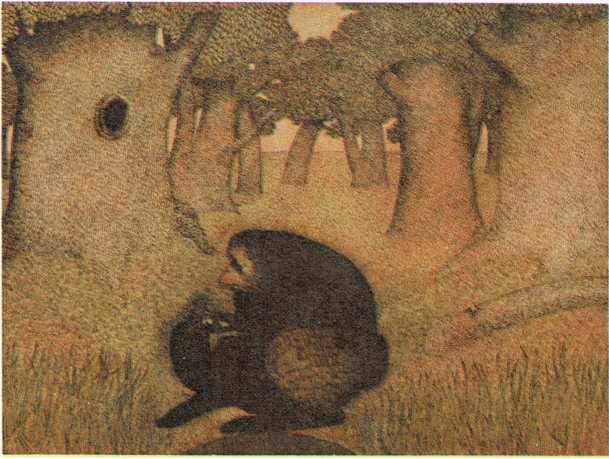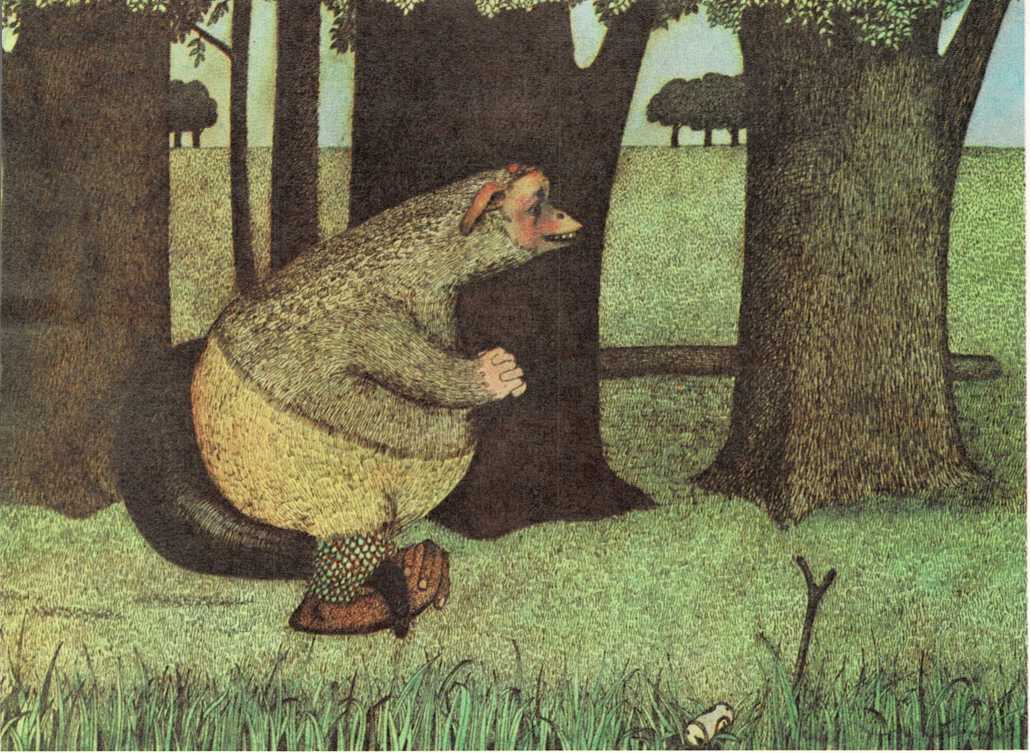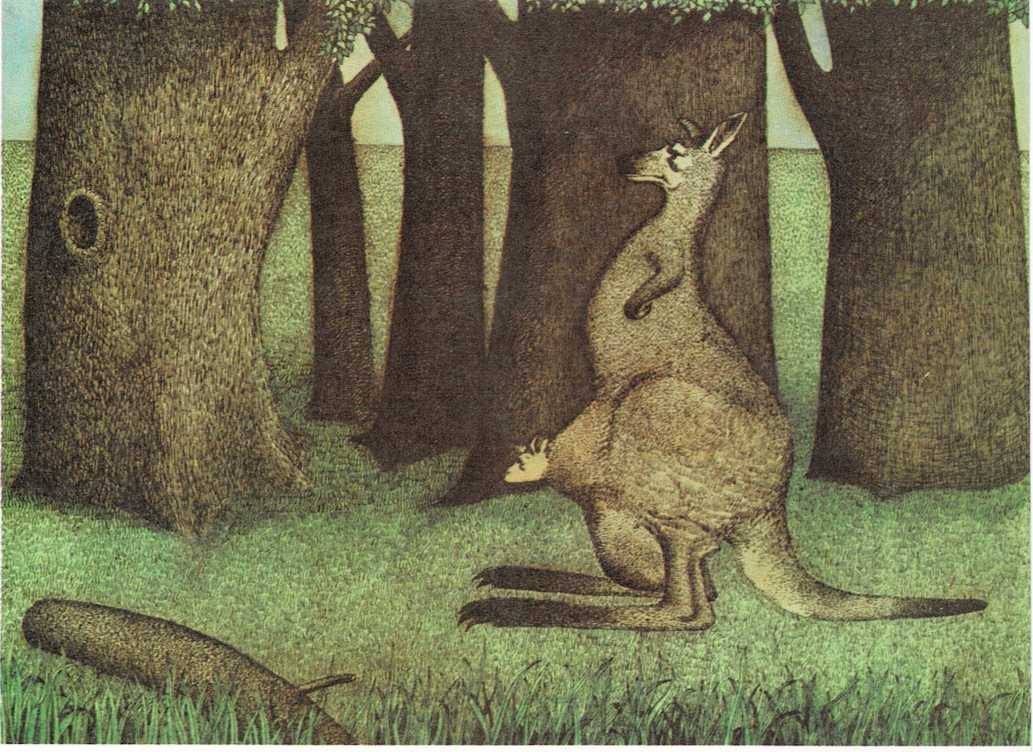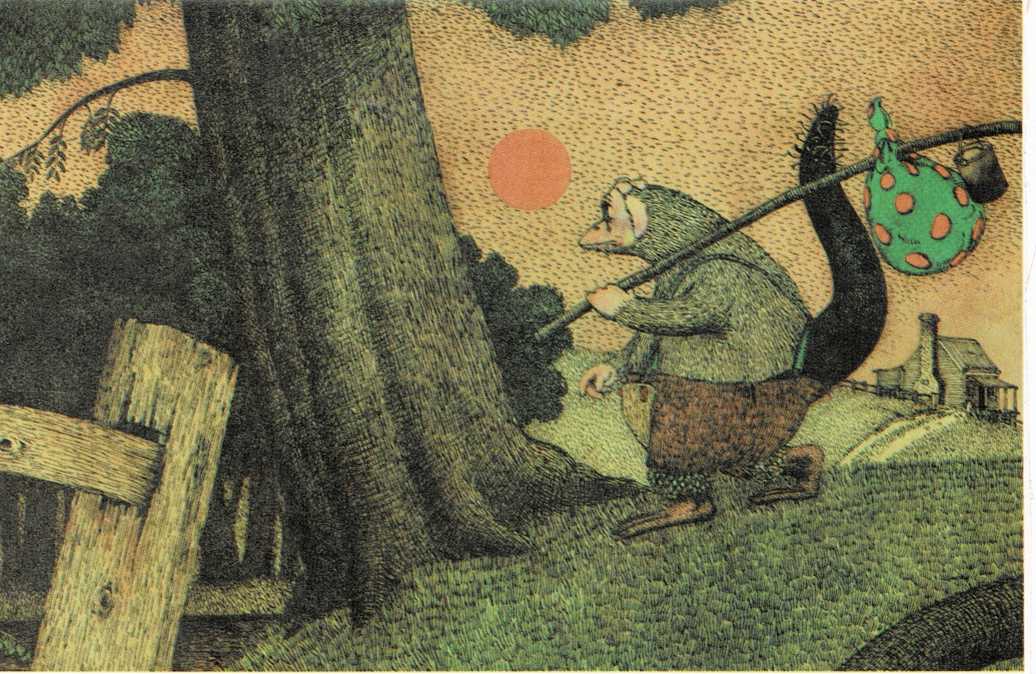
The Bunyip of Berkeley’s Creek
by Jenny Wagner
illustrations by Ron Brooks
Late one night, for no particular reason, something stirred in the black
mud at the bottom of Berkeley’s Creek.
The fish swam away in fright, and the night birds in the trees hid their
heads under their wings. When they looked again, something very large
and very muddy was sitting on the bank.
“What am I?” it murmured. “What am I, what am I, what am I?” And the
night birds quickly hid their heads under their wings again.
In the morning the thing was still sitting there, scraping the mud off
itself to see what was underneath.
“What am I?” it kept saying. “What am I?” But the night birds were all
asleep.
A passing platypus solved the problem. “You are a bunyip,” he said.[^8]

“Bunyip,” murmured the bunyip contentedly.
“Bunyip.” Then he sat up straight and called out. “What do I look like?”
But the platypus had dived into the creek. “Am I handsome?” called the
bunyip. “Am I?” But nobody answered him, and the bunyip went on sitting
there for a long time, lost in thought.
Presently a wallaby came by to drink at the creek. “What do bunyips look
like?” asked the bunyip.
“Horrible,” said the wallaby. “They have webbed feet, and feathers.”
“Fine, handsome feathers,” said the bunyip hopefully.
“Horrible feathers,” said the wallaby firmly, and finished her drink and
hopped off.
“Handsome webbed feet?” called the bunyip, but there was no answer. The
bunyip sighed and walked off to find someone else.
There was a rustling in the bushes behind him, and

suddenly an emu shot past. “Wait!” called the bunyip, running after him.
“What do bunyips look like?”
The emu stopped and considered. “They have fur,” he said at last, “and
tails.”
“How many tails?” asked the bunyip.
“One to each bunyip,” replied the emu.
“Fine, handsome tails,” said the bunyip.
“Horrible tails,” said the emu. “And even more horrible fur.” And he
settled his feathers and crouched down low, and streaked off into the
distance.
The bunyip wandered sadly along the creek. “Will someone tell me what
bunyips look like?” he said, to anyone who would listen.
But there was no answer.
Further along the creek he met a man. The man was busy with a notebook
and pencil, and did not look at the bunyip. “Sh,” he said, “I’m busy.”

The bunyip waited for a long time, and then he said, very slowly and
clearly, “Can you please tell me what bunyips look like?”
“Yes,” said the man, without looking up. “Bunyips don’t look like
anything.”
“Like nothing?” said the bunyip.
“Like nothing at all,” said the man.
“Are you sure?” said the bunyip.
“Quite sure,” said the man, and looked right through him. “Bunyips
simply don’t exist.”
The bunyip was shaken. Then he sighed a long, deep sigh. “What a pity,”
he murmured. “What a pity, what a pity.” And he walked slowly back to
his waterhole. Then he fished his belongings out of the water, packed
them in his bunyip bag, and walked away. No one saw him go.
The bunyip walked all day, and just as the sun was setting he came to a
quiet, still billabong.[^9] “This will do,” said the bunyip himself. “No
one can see me here. I can be as handsome as I like.” And he unpacked
his bag, and laid his bunyip comb and mirror out on the sand, and put
his billy ^3^ on to boil. No one saw him and no one spoke to him.
But late that night, for no particular reason, something stirred in the
black mud at the bottom of the billabong. The bunyip put his comb down
in surprise, and stared. Something very large and very muddy was sitting
on the bank.
“What am I?” it murmured. “What am I, what am I?” The bunyip jumped up
in delight. “You are a bunyip!” he shouted.
“Am I? Am I really?” asked the other bunyip; and then, “What do I look
like?”
“You look just like me,” said the bunyip happily. And he lent her his
mirror to prove it.
3. A hilly is a can for cooking over an open fire.

